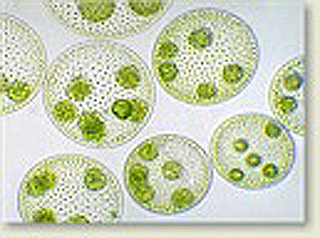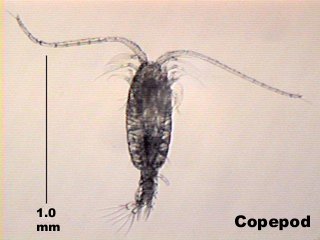 |
| back
to data |
|
|
Plankton refer
to marine organisms that cannot swim against the current. They are generally
free-floating, and many have physical structures that help them either
move up and down the water column or remain buoyant (i.e. suspended) near
the surface. Plankton can be microscopic, like diatoms and radiolarians,
or stretch up to 130 ft in length, like some colonial siphonophores. In
this investigation, it is the microscopic plankton that is of importance.
Microscopic
plankton are the base of the food webs in the marine environment. Therefore,
their presence and availability influences the abundance of countless
other marine organisms.
|
 |
 |
|
Plankton that
can carry out photosynthesis to produce their own food are known as phytoplankton.
These are the "plants" in the ocean. They produce most of the
oxygen in the air that we breathe, and form the base of almost all food
chains in the ocean. Their abundance is influenced by the availability
of nitrogen and phosphorous.
|
Almost all organisms
in the ocean start out their life as a microscopic zooplankton. These are
the egg and larval stages of their lives. Some zooplankton eventually grow
into a large adult stage, like anchovies, blue crabs, corals, sea urchins,
etc. Other animals remain small their entire life, such as copepods and
krill. |
|

(www.chesapeakebay.net/info/plankton.cfm)
|

(www.cnas.smsu.edu/zooplankton/epischura.htm)
|
| HOW
IS PLANKTON IMPORTANT? |
|
Phytoplankton
make nitrogen into a chemical form that is usable by marine
animals. N & P are locked in organic material (as the
amino acids, protein, and DNA) even after death. Dead organic
material sink to the ocean bottom, and are consumed by other
organisms on the way down or decomposed by bacteria.
N
is put back into the marine environment via animal waste and
byproduct from bacterial decomposition. Phytoplankton take
up this nitrogen in the water during photosynthesis, and animals
acquire the necessary nitrogen when they consume the phytoplankton.
However, phytoplankton are not found at the ocean bottom.
Phytoplankton rely on upwelling mechanisms to vertically transport
N & P back up to the surface.
|
|

(www.soc.soton.ac.uk/CHD/education/posters/productivity.html)
|
|
|
| NITROGEN
AND PHOSPHOROUS |
|
Aside
from oxygen and carbon dioxide, all organisms need other essential
nutrients to survive. Nitrogen (N) and phosphorous (P), in
the form of nitrates and phosphates, are needed for producing
amino acids and ATP. Amino acids are the building blocks of
protein, which are essential for life. ATP is cellular energy,
thus without ATP cellular activity would not take place.
Autotrophs,
like phytoplankton, can take up nitrates and phosphates from
the water. Heterotrophs, like zooplankton and fish, acquire
N & P by consuming organic material, such as phytoplankton,
other animals, or waste products. Heterotrophs need autotrophs
to transform nitrogen and phosphorous into a chemical form
that they can actually use.
|
|
|
|
The high availability
of nitrogen and phosphorous along Peru's coast makes it a rich environment
to support an abundance of anchovies.
- What
happens to the anchovy population when there is a reduction in plankton
supply?
- What
can alter the plankton supply?
- When
would you expect plankton to be most abundant?
|
| back
to data |
|
| |
|
This web
site was created by Lynn Tran at the North Carolina State University, Department
of Mathematics, Science, and Technology Education on 7/12/03. Faculty advisor
Dr. David Eggleston, NCSU, Department of Marine, Earth, & Atmospheric Sciences.
Last updated
December 29, 2003
.
|


